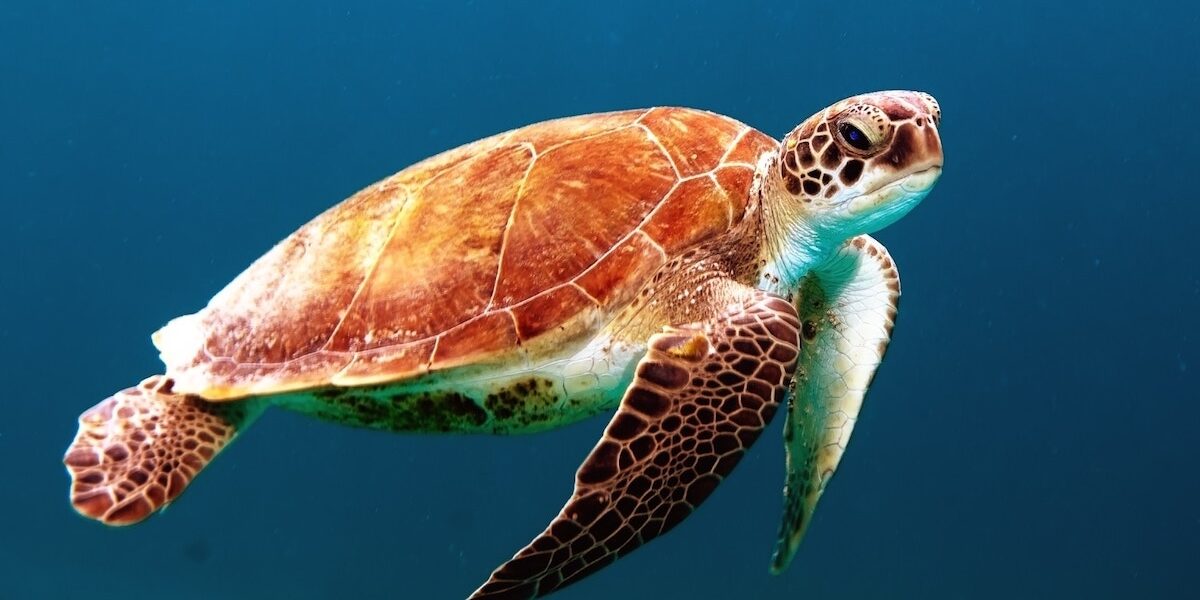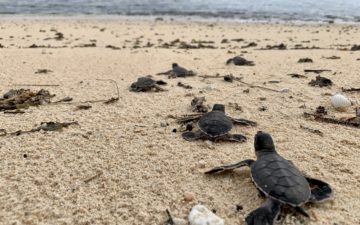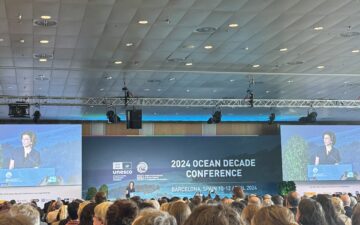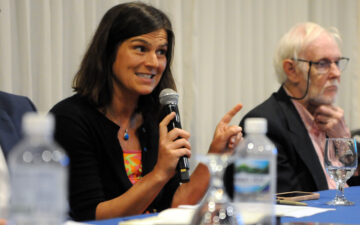By Brad Nahill, Director & Co-Founder of SEEtheWILD and SEE Turtles
Working with Local Teachers to Expand Sea Turtle Education Programs in El Salvador
Only a few hundred female hawksbills are estimated to nest along the entire eastern Pacific coastline. (Photo Credit: Brad Nahill/SeeTurtles.org)
The young students make their way out to the covered dock, smiling nervously to each other in their white tops and blue pants and skirts. Two boys eagerly volunteer to be crabs, their eyes lighting up at the chance to consume their classmates-turned-turtle-hatchlings. Pincers at the ready, the boys move sideways, tagging the kids who are pretending to be baby turtles making their way from the beach to the ocean.
Several “turtles” make it through the first pass, only to see the crabs become birds ready to pluck them off the water. After the next pass, just a couple of students are left facing the daunting task of eluding the boys, who are now playing sharks. Only a couple of hatchlings survive the gauntlet of predators to survive until adulthood.
Bringing the world of sea turtles to life for students near turtle hotspots has been a part of turtle conservation programs for decades. While a few larger conservation organizations have the resources to run full educational programs, most turtle groups have limited staff and resources, allowing them to make just a couple of visits per nesting season to local schools. To help fill this gap, SEE Turtles, in partnership with Salvadoran organizations ICAPO, EcoViva, and Asociación Mangle, is creating a program to make sea turtle education a year-round activity.
Sea turtles are found around the world, nesting, foraging, and migrating through the waters of more than 100 countries. Depending on where they live, they encounter many threats including consumption of their eggs and meat, use of their shells for handicrafts, entanglement in fishing gear, and coastal development. To counter these threats, conservationists around the world patrol nesting beaches, develop turtle-safe fishing gear, create ecotourism programs, and educate people about the importance of protecting turtles.
In El Salvador, consuming turtle eggs has only been illegal since 2009, making education an especially important tool for conservation. Our goal is to expand upon the work of our local partners to bring resources to local schools, helping teachers develop lessons that reach their students in ways that are active and engaging. The first step, completed in July, was to hold workshops for teachers that work around Jiquilisco Bay, home to three species of turtles (hawksbills, green turtles, and olive ridleys). The bay is the country’s largest wetland and one of only two major nesting areas for the critically endangered Eastern Pacific hawksbill, possibly the world’s most threatened sea turtle population.
(Photo Credit: Brad Nahill/SEEturtles.org)
Over three days, we held two workshops with more than 25 teachers from 15 local schools, representing more than 2,000 students in the area. In addition, we also had in attendance several youth from Asociación Mangle who are participating in a leadership program, as well as two rangers who help monitor the bay and a representative from the Ministry of Education. This program was partially funded by National Geographic’s Conservation Trust in addition to other donors.
Teachers, like students, learn better by doing than watching. SEE Turtles education coordinator Celene Nahill (full disclosure: she’s my wife) planned the workshops to be dynamic, with lectures on biology and conservation interspersed with activities and field trips. One of our goals was to leave the teachers with simple games to help their students understand sea turtle ecology, including one called “Mi Vecino Tiene,” a musical chairs–type game where participants act out the behavior of animals of the mangrove ecosystem.
On one of the field trips, we took the first group of teachers out into Jiquilisco Bay to participate in a research program with black turtles (a sub-species of green turtle). These turtles come from as far away as the Galapagos Islands to forage on the bay’s seagrass. Seeing a head pop up for air, fishermen working with ICAPO quickly circled the turtle with a net and hopped in the water to bring the turtle into the boat. Once aboard, the research team tagged the turtle, collected data including its length and width, and took a skin sample before releasing it back into the water.
The low nesting numbers suggest that the species is unlikely to survive without coordinated conservation actions to protect eggs, increase hatchling production, generate biological information and protect key marine habitats. (Photo Credit: Brad Nahill/SEEturtles.org)
While SEE Turtles and ICAPO bring people from around the world to work with these turtles, it is rare for people living nearby to witness the research. We feel that the best way to learn about these animals and appreciate their importance is to see them up close, and the teachers heartily agreed. We also took the teachers to ICAPO’s hatchery to learn how the researchers protect the turtle eggs until they hatch.
Another highlight of the workshops was the opportunity for the teachers to use their new tools with a group of students. The first- and second-grade classes from the nearby school came to the workshop site and field-tested some of the activities. One group played a variation of “Rock, Paper, Scissors” in which the kids competed to pass from one phase of the turtle life cycle to the next, while the other group played the “Crabs & Hatchlings” game.
According to surveys, the teachers’ average level of knowledge about turtles more than doubled after the workshops, but these workshops are just the first step in a long-term program to help El Salvador’s turtle conservation projects develop a national sea turtle educational curriculum. Over the next few months, these teachers, many with help from Asociación Mangle’s youth leaders, will plan “sea turtle days” at their schools with new lessons we develop. In addition, the older classes from several schools will participate in hands-on research programs.
Over the long-term, our goal is to inspire El Salvador’s students to experience the wonder of sea turtles in their own backyards and actively participate in their conservation.
http://hawksbill.org/
http://www.ecoviva.org/
http://manglebajolempa.org/
http://www.seeturtles.org/1130/illegal-poaching.html
http://www.seeturtles.org/2938/jiquilisco-bay.html







